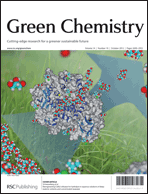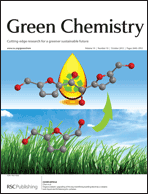The latest issue of Green Chemistry is now available to read online.
 The front cover of issue 10 highlights work by Ulrich Schwaneberg and colleagues from RWTH Aachen University, nova-Institut GmbH and the University of Hamburg, Germany. The aim of this study was to generate re-engineered cellulases which can match application demands in biorefineries and avoid expensive downstream processing. The team developed a fluorescence-based high throughput screening method for directed evolution of cellulases, in an effort to improve the activity and resistance of a cellulase in aqueous solutions of deep eutectic solvents and concentrated seawater. This work opens up new opportunities for the development of cellulases as catalysts for the depolymerisation of cellulose under mild conditions.
The front cover of issue 10 highlights work by Ulrich Schwaneberg and colleagues from RWTH Aachen University, nova-Institut GmbH and the University of Hamburg, Germany. The aim of this study was to generate re-engineered cellulases which can match application demands in biorefineries and avoid expensive downstream processing. The team developed a fluorescence-based high throughput screening method for directed evolution of cellulases, in an effort to improve the activity and resistance of a cellulase in aqueous solutions of deep eutectic solvents and concentrated seawater. This work opens up new opportunities for the development of cellulases as catalysts for the depolymerisation of cellulose under mild conditions.
Reengineering CelA2 cellulase for hydrolysis in aqueous solutions of deep eutectic solvents and concentrated seawater, Christian Lehmann, Fabrizio Sibilla, Zaira Maugeri, Wolfgang R. Streit, Pablo Domínguez de María, Ronny Martinez and Ulrich Schwaneberg, Green Chem., 2012, 3, 2719-2726
 The inside front cover of this issue features work by Eugene Chen and co-workers from Colorado State University who present an efficient process for upgrading 5-hydroxymethylfurfural (HMF) to 5,5′-di(hydroxymethyl)furoin (DHMF), a promising intermediate for kerosene/jet fuel. The reaction was performed in an ionic liquid [EMIM]OAc and catalysed by N-heterocyclic carbenes. The process could be completed in 1 hour at an ambient atmosphere and 60-80°C, which are industrially favourable conditions.
The inside front cover of this issue features work by Eugene Chen and co-workers from Colorado State University who present an efficient process for upgrading 5-hydroxymethylfurfural (HMF) to 5,5′-di(hydroxymethyl)furoin (DHMF), a promising intermediate for kerosene/jet fuel. The reaction was performed in an ionic liquid [EMIM]OAc and catalysed by N-heterocyclic carbenes. The process could be completed in 1 hour at an ambient atmosphere and 60-80°C, which are industrially favourable conditions.
Organocatalytic upgrading of the key biorefining building block by a catalytic ionic liquid and N-heterocyclic carbenes, Dajiang (D. J.) Liu, Yuetao Zhang and Eugene Y.-X. Chen, Green Chem., 2012, 3, 2738-2746
Stay up-to-date with the latest news and content in Green Chemistry by registering for our free table of contents alerts.












